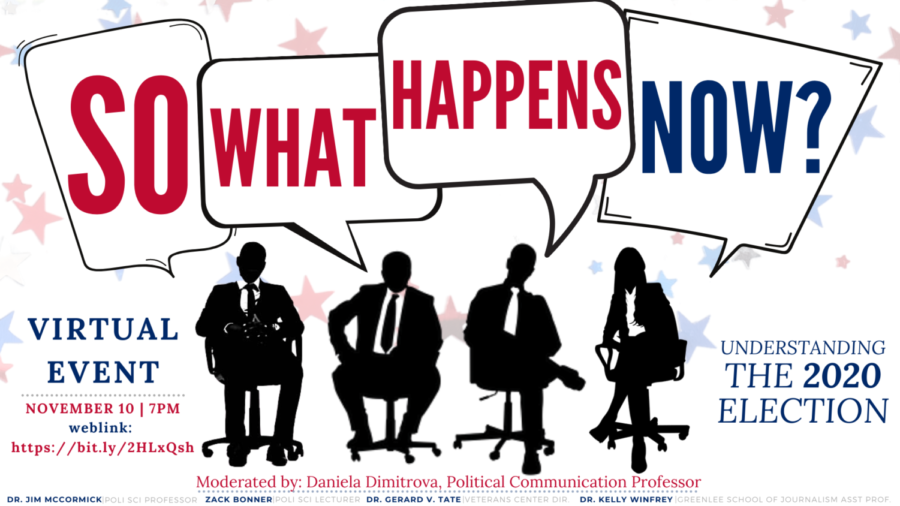Panel clarifies questions and concerns during election forum
James McCormick and Zack Bonner of the political science department joined fellow panelists Kelly Winfrey of the Greenlee School of Journalism and Communication and Veterans Center Director Gerard Tate to discuss issues relating to the 2020 election.
November 10, 2020
The 2020 election cycle has brought up many questions for voters all across the country. In an attempt to answer these questions for students, Iowa State’s Committee on Lectures and the political science department co-hosted a virtual panel titled “So What Happens Now?: Understanding the 2020 Election” on Tuesday.
Daniela Dimitrova, professor of the Greenlee School of Journalism and Communication and the panel’s moderator, enlisted four field experts from Iowa State to assist the understanding of these election results and where the United States goes from here.
James McCormick and Zack Bonner, respective professor and lecturer of the political science department, joined fellow panelists Kelly Winfrey, assistant professor of the Greenlee School of Journalism and Communication, and Gerard Tate, director of the Veterans Center.
The night covered an extensive number of topics, ranging from voter turnout and polling data to polarization and battleground states. The night’s questions covered a wide range of elections, from the Iowa Legislature to the presidential election, and how the unique circumstances that followed this election cycle impacted the results of each race and future races.
The high voter turnout of the 2020 election was discussed first. McCormick said a record number of more than 148 million Americans voted during this election, or approximately 62 percent of eligible voters this cycle.
According to McCormick, this record number of voters is due in large part to the extensive mail-in voting participation this cycle. In future election cycles, the mail-in voting process may have additional steps added to standardize the process throughout each state. Though this would create a uniform system, the new requirements may lower mail-in voting turnout in future races.
On the topic of polarization, Bonner said this problem will likely continue in the near future, especially if Trump remains an active voice in the Republican Party during future elections and administrations.
“We don’t even agree on what the facts are across the aisle,” Winfrey said. “We don’t agree on science and all sorts of things that used to not be debatable.”
McCormick ended the polarization discussion with statistics from Gallup polls on Media Trust. The data shows that only 41 percent of Americans trust the media, including 70 percent of Democrats, 10 percent of Republicans, and 36 percent of independents. The levels of media trust are drawn along party lines, which only expands the polarization amongst Americans as opposing sides continue to view opposing media perspectives.
Additionally, the Trump campaign has filed lawsuits following the Nov. 3 election with claims of voter fraud. Dimitrova brought this topic to the panel for insight into the validity of these claims.
“In terms of the lawsuits that he and his staff are putting together right now, a lot of them hinge on voter fraud, which in many cases is completely unproven,” Bonner said.
The 2020 elections are not the first time President Donald Trump and his campaign have discussed the presence of voter fraud in his elections. On the campaign trail and during presidential debates, Trump has announced the prevalence of this issue to his supporters.
“This isn’t as much of an actual, legitimate complaint about the validity of votes as it is a PR strategy to protect his image, maintain Republican loyalty and enthusiasm and sow polarization,” Winfrey said, offering the media’s perspective.
With the presidential election just one week ago, the panelists responded to which factors were most important on the outcome of this election.
“Fear is always a motivating factor,” Tate said. “Racism was a key factor, but fear of what the country was turning into, a fear of violence, a fear of racial unrest … fear of what the next four years with the current administration will look like.”
Dimitrova changed the discussion to errors in polling data in both the 2016 and 2020 election cycles. Neither of these polling predictions were entirely accurate, though Winfrey attributes this to the margins of error. She called on voters to be responsible, critical media consumers and to read the fine print of each poll.
Bonner said the polling data as a whole is a bell curve, and the results of this election fall well within the projections of likely outcomes.
In the discussion about Iowa’s continued status as a swing state, all four panelists agree the Democratic Party is fighting an uphill battle in rural portions of the state, especially against Republican incumbents. Winning control of the Iowa Legislature may prove to be even more difficult than winning the Senate and gubernatorial races in the 2022 midterm elections.
In final messages to the audience, each panelist sent a message to young and first-time voters.
“You aren’t going to win every election,” Bonner said. “Your candidate isn’t going to win every primary or general election. But there’s always another election. … Find candidates that really appeal to your own personal beliefs and get out there and volunteer for them.”







